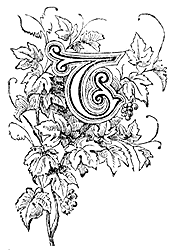
HIS most picturesque old house is situated on the Staffordshire border of Cheshire. It has on its eastern side the range of hills that extends from Scotland to the centre of England.
Here, too, they present their most picturesque aspect, in the lofty hills called "Mow Cop" and "Cloud," both of which are more than a thousand feet above the level of the sea. Mow Cop is crowned by a ruined tower, and by an isolated dome-shaped rock. On the side within view of Moreton windows these hills are finely covered with Scotch firs. Moreton Hall is an ancient timbered house, with black beams and star-like patterns traced on the white plaster.
It is surrounded by a narrow moat, at the Southwestern corner of which is a small mount, surmounted by a sycamore tree. The moat is crossed by a stone arch. The portal is square, the top and sides of well carved oak. Passing through it, we find each door-post leading into the inner court adorned with a carving of a halbert-bearer. in high relief, at the top of it.
Above this portal rises the building, containing a number of rooms, generally small, and all wainscoted. An oaken staircase leads to a large room or gallery, that runs over all the rooms below, and is sixtyeight feet long, it is lighted from the south by a large window its whole length, and is wainscoted, except the ends of the gallery, where, on the upper part, are figures and tablets with inscriptions in stucco. That at the eastern end represents Fate supporting a globe with one hand, a pair of compasses in the other. The inscription is,-
At the western end is blind Fortune with her wheel, bearing this motto on its rim,-
The inscription is,-
The gallery has a pitched roof and an oaken ceiling open to the rafters. Tradition says that Cromwell used this apartment as a council chamber during the civil wars
Descending from this room, and passing out at the back door, nearly opposite the portal we enter a small court, into which seven doors open, and two large gabled bow windows, with several others. These bow windows light the Banqueting Hall. Their glazing is curious; the panes are small and joined by slips of lead in pretty patterns, some few being painted; upon bands round the windows are these inscriptions:
"God is al in al thing. This window where made by William Moreton in the yeare of oure Lorde MDLII.
"Richarde Dale, carpender made theis windows, by the grace of God."
Men who took the pride in their work that this carpenter did, and acknowledged from Whom they had their skill, worked better, as we still see, than our modern workmen.
On the right hand of the court one of the many doors leads into a small chapel, not used, and only showing that it was a place of worship by tablets suspended on the walls bearing on them texts of Scripture in old English characters.
The entrance to the house is closed by a heavy oaken door, with a small wicket in it, fastened with an immensely heavy bolt.
We now enter the old Banqueting Hall; a large wainscoted apartment with seats fastened to the wainscot all round it, and a long and fine old table of oak standing in it. This room, as we have said, is lighted by the bow-windows giving into the court, which have some stained glass in them with heraldic paintings of the Moretons and other families. A door leads from the Banqueting Hall into the living-room or drawing-room of the family, which also looks into the court. It has a carved chimney-piece surmounted by arms in stucco; the motto, "Honi soit qui mal y pense," and a large A on each side of it.
Many of the floors of Moreton House are made of plaster; and some of the bedroom doors are fastened with a bar of wood passing through an iron ring in the middle of the door and resting on the jambs at each side.
The house is still in the possession of the Moreton family, as it has been since the thirteenth century.
There is a cross in the garden, upon which is placed an old sun-dial. Moreton Hall is sometimes called Little Moreton Hall, to distinguish it from the residence of the Bellots in the near neighbourhood.
|